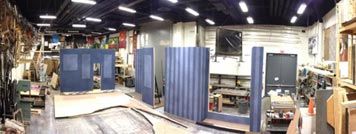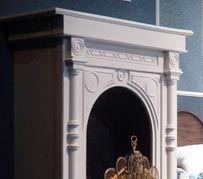
When creating the set for a stage production of Peter Pan, original author J.M. Barrie might have said that "All you need is a little faith, trust and… pixie dust!". In this case though a "CNC machine, Materials and Vectric's Aspire software" worked out better for Marion Powell and his students at Southeast Missouri State University!
We first saw the impressive theatre props (in the images to the right and below) on the ShopBot forum where Marion shared information about what his team had been working on. After reading the post we got in touch to find out more about how they are using Vectric software and CNC technology to create these immersive sets.
Marion begins by telling us how he started out in this industry, then goes on to tell us more about his teams involvement with set production, why they started using CNC, and shares further information about how they created pieces from the Peter Pan set you can see above right.
"I have been working in theatre for over a decade now. I started as a technician out of college and worked my way up through various positions and jobs learning as much as I could in each one. In theatre one must quickly become a jack of many trades.
The team I currently work with uses many different materials, including wood, metal, foam, plastic and fabrics. We use traditional and industry specific construction methods, which often involve a lot of planning and problem solving. Often we have to devise ways for a piece of scenery to look realistic but weigh a fraction of what the real article would.
For each show that we build, we create a combination of standard pieces and very unique elements using many different techniques. We are always looking for new ways to save time; this is what led me to look at CNC technology. I was surprised to find that the Shopbot CNC machines offered a good mix of affordability, features and ease of use. Upon receiving our Shopbot it wasn't long before we had it up and running to help build productions using the PartWorks software (a ShopBot branded version of Vectric's VCarve Pro) that came with it. The first time I used the CNC for production I was able to shave two weeks off the expected build time! Realising how powerful the machinery and software was, we didn't hesitate to upgrade to Vectric's Aspire product which allowed us to add 3D modeling and machining to the existing 2D and 2.5D features."
Marion continues by explaining the production process, from preliminary sketches through to using time saving techniques he became familiar with whilst using the CNC…
“Each and every production is different. It all starts with the Director of the show and the Scenic Designer sitting down with the script and deciding the direction of a production, the period, style, size, colour, etc. The Designer then creates sketches and renderings followed by preliminary design drafts and sometimes a scale model to ensure the set has the desired look. Once happy with the design he then creates finished renderings and scale CAD drawings. At this point the design package is handed off to be priced out and looked over for build feasibility.
At Southeast Missouri State University this is the stage I start to get involved as the Scene Shop Supervisor. In short I help to make sure that what has been designed becomes a reality. Working with the Designer we decide what materials and methods are best suited to our budget and build time. Once everything has been decided we can take advantage of the CNC!
The CNC has saved us a lot of time creating scene elements. In the past when we wished to cut out large shapes we would lay out the material, either grid out the image or use a projector to trace the image before taking each sheet to be cut out by hand. Now with the CNC I import my CAD files into Aspire and within minutes have the toolpaths ready for cutting. Each piece of scenery is constructed in sections in the shop then moved and installed in the theatre at a later date. These elements can also be fixed installations, installed on wagons in order to move on and off stage, or rigged to fly up and down using the theatre system fly system. It all depends on the show and design.
A prime example of how the software has helped in Peter Pan where some elements were in excess of 30’. I loaded the CAD file of each piece, did the toolpathing and then took advantage of the toolpath tiling feature to automatically break the piece down into 4x8 sheets we could cut on the CNC. The sheets were then quick and easy to assemble and fit together like a well-made puzzle!”
Marion continued by providing information on some specific pieces they had created for the Peter Pan set…
Fireplace:
"I worked with one of our students on the fireplace for the production of Peter Pan. He did the layout design in CAD and then using his input I went into Aspire and modelled it. The underlying structure is a steel frame with a plywood top for Peter to land on during a flying scene. The steel frame was faced with foam fireplace facade.
The front portion consisted of several 2" layers of foam that were modelled then 'sliced' in Aspire. The cylindrical portion of the column was modelled in our standard CAD software Vectorworks and then imported into Aspire where I modelled and added the top and bottom elements. It was then assembled, coated in a material to prime and protect the foam, painted, a bit of traditional trim applied and ready for an audience."
Skull & Cross Bones:
"For the Skull and Crossbones the designer supplied me with a vector outline which I took into Aspire. I split the piece down the middle so that there were two halves to split the double swing doors. The eyes of the skull were pocketed out and the basic shape was cut out using a profile toolpath. We finished off with some hand shaping and carving, paint and applied it to the custom made doors, cut out on the CNC of course. Also pictured are the curved staircase and railing which we cut on the CNC as well."
Pocket Watch:
"The Designer originally asked that the giant Pocket Watch profile be cut out on the CNC with the intent of hand carving. I took the Designer's Vector drawings and again using Aspire built a model to show the Designer. The Designer loved the model and we cut it out in three 2" slices to be assembled and painted. This allowed a lot more dimension then the original 2" foam cutout idea. "
Marion concluded by telling us about their next project, "Our next show is titled 'Brighton Beach Memoirs'. This is a functional two-story set of a home interior. We are already underway and have utilized the CNC on some custom stair units."
We'd like to thank Marion for taking the time to share information about how CNC and Vectric software was utilized in the creation of these fantastic set elements. It's great to see how the software helps reduce the time it takes to make the parts without compromising on quality and even offers more creative opportunities. We're looking forward to seeing further work from the team over at Southeast Missouri State University.
You can learn more about Marion and her team, as well as Southeast Missouri State University over at http://www.semo.edu/theatreanddance/




Vectric Ltd
Precision House
2 Arden Road
Alcester
B49 6HN
Registered in England Number 05382596
VAT Registration GB115123072
Privacy Policy |
Cookie Policy |
Terms and Conditions